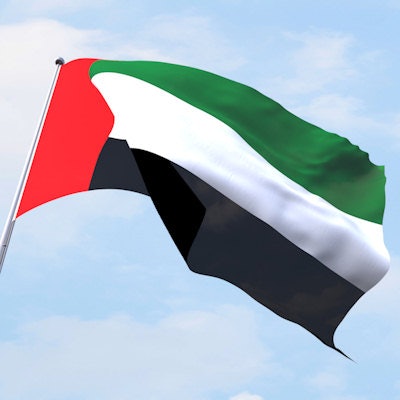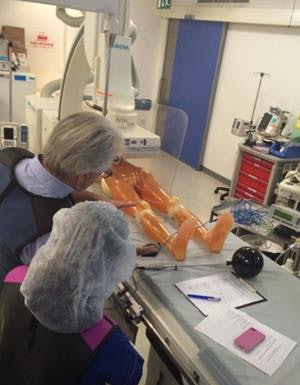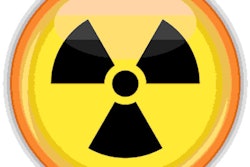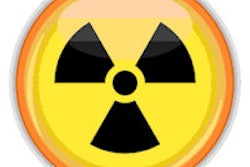
Moves to limit medical radiation exposure are intensifying in the United Arab Emirates (UAE), and safety issues and education now are high on the agenda of healthcare professionals. Every effort must be made to reduce exposure and boost risk awareness, according to key participants at next month's summit in the region.
As part of the three-day Middle East Patient Safety congress to be held in Dubai, the Radiological Safety Conference on 6 October will cover the latest thinking on radiation protection and dose minimization, as well as outline regulatory guidance and national framework.
 Staff undergoing dose-related training at Al Ain Hospital. All images courtesy of Wadha Al Shamsi.
Staff undergoing dose-related training at Al Ain Hospital. All images courtesy of Wadha Al Shamsi.Session speaker Wadha Al Shamsi, medical physicist and chief medical officer for clinical imaging at Al Ain Hospital, believes that the increase in the region's radiological medical services has generated an urgent need for greater numbers of radiation safety courses.
"The focus now should be on healthcare personnel who are not in radiation-related occupations but who use ionizing radiation as a part of their work, such as endoscopy and dental personnel, and those working in theater, specifically in orthopedics," noted Al Shamsi, who is a board member of the Emirates Medical Physics Society. "The objectives of my session are to recognize the effects of radiation, explain the aim of radiation protection and how to apply general measures, outline the role of the qualified expert and radiation protection officer, and show how establishing a culture of radiation safety improves practice."
At Al Ain Hospital, staff members who work with medical radiation have become more aware of the risks of unjustified irradiating procedures, she noted. They undergo radiation safety training and an annual exam to best protect the individual and prevent contamination.
"The program is primarily for staff involved in x-ray. It is the responsibility of the individual staff member to understand and conduct operations in an acceptable manner to minimize hazard to him- or herself and to others," she said.
In addition, a yearly workshop has taken place since 2014 in collaboration with the International Atomic Energy Agency (IAEA). The first workshop in December 2014 covered patient radiation safety and dosimetry in interventional radiology and mammography, while the second in October 2015 covered referral guidelines and was aimed at referring physicians.
At the end of this month, a third workshop will be held in Al Ain, focusing on revision of -- and advice on -- radiology guidelines and procedures.
Dose and radiation safety awareness has improved across the UAE's health services since the creation in 2009 of the Federal Authority for Nuclear Regulation. The independent government body is charged with regulating and licensing nuclear activities in the UAE, which in addition to the nuclear power program, includes radioactive material and radiation sources used in medicine.
 Radiation safety courses should target nonradiology staff such as endoscopy, dental, and orthopedic surgery personnel, according to Wadha Al Shamsi (far right), shown here with colleagues at Al Ain Hospital.
Radiation safety courses should target nonradiology staff such as endoscopy, dental, and orthopedic surgery personnel, according to Wadha Al Shamsi (far right), shown here with colleagues at Al Ain Hospital.At the local level, Al Ain Hospital policy requires all procedures involving ionizing radiation to comply with the relevant UAE protection laws (Federal Law No. 20 of 2006) and rulings made by the Ministry of Energy and the Federal Authority for Nuclear Regulation.
Wider regional safety efforts hinge on collaborative work between Dubai's Health Authority and Dubai's Ministry of Health, in collaboration with Health Authority-Abu Dhabi and Abu Dhabi Health Services, as well as the Armed Forces' Medical Service.
According to Al Shamsi, the most successful work includes the IAEA-UAE National Program for Radiation Safety in Medical Applications, which started in 2009 and is led by Dr. Jamila Al Suwaidi, chair of the health authority's Radiation Protection Committee.
The program aims to ensure that the principles of justification, optimization, and dose limitation are the basis of any medical radiation-related activity, and it is overseen by a committee comprising medical physicists from the main government and private hospitals in the UAE and also members of the other key organizations. In 2015, the committee established the UAE diagnostic reference levels for CT, mammography, dental imaging, and nuclear medicine.
The program's latest project, Enhancing Quality Assurance for the Use of Radiation in Healthcare, prioritizes adopting and harmonizing guidelines and procedures in radiology, nuclear medicine, and radiotherapy to meet global standards, as well as quality assurance and patient safety training for the staff in these three fields.
Although radiation safety promotion has led to an increase in awareness and better practice, including a boost in numbers of radiation protection officers, more can be done to tighten up safety culture, according to Al Shamsi.
"Training courses should be targeted more specifically at medical physicists as it is these staff who are responsible for spreading awareness," she stated, adding that the media also had an important role in raising public awareness about radiation risks. "TV or radio interviews with a medical physicist or radiology technician would allow public questions about radiation safety to be answered. Also, such exchange with the public could help to gauge awareness levels. I see that the current generation has an increased awareness of radiation risk and will question the need for procedures and the risks involved, as well as request aprons and shields during imaging exams."
In addition, she cited the necessity for studies targeting nonradiology medical staff to evaluate knowledge, perception, and mitigation of radiology-related hazards and also the need for further effort at authority level.
"UAE regulatory bodies need to work collaboratively and more effectively to adopt and harmonize guidelines and procedures in radiology, nuclear medicine, and radiotherapy to meet global standards across the UAE," she concluded.
For more details on the 6 October meeting, visit the conference website.




















